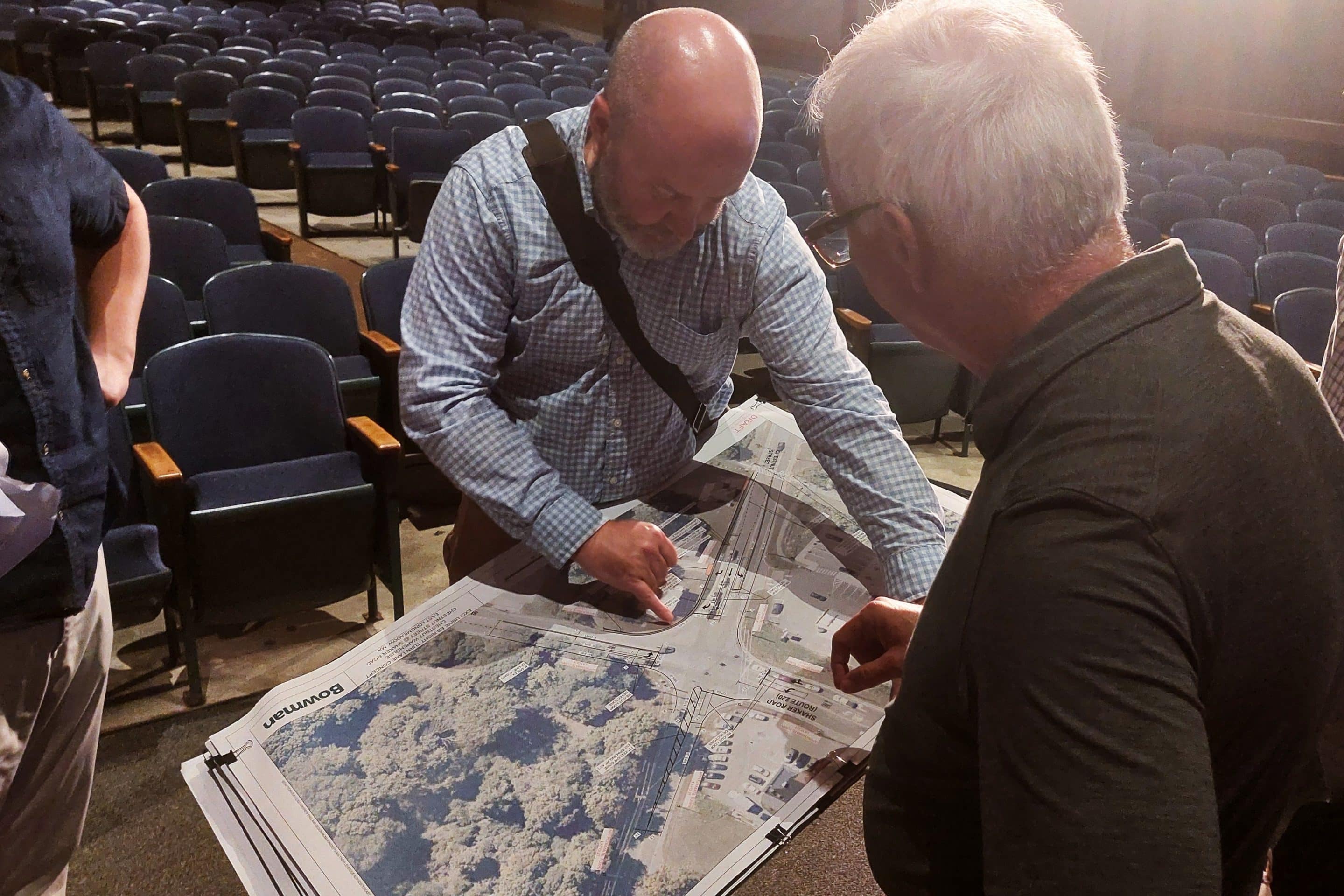Civil Engineer Jason Adams of Bowman Consulting shows Planning Board Chair Russell Denver how the intersection of Chestnut Street and Shaker Road could be widened.
Reminder Publishing photo by Sarah Heinonen
EAST LONGMEADOW — The Planning Board reconvened the public hearing on a proposed set of four warehouses at 330 Chestnut St. on Oct. 7.
The project, a redesign of a warehouse denied by the board in 2023, has created concern from abutters at the Fields at Chestnut Condominiums.
Planning and Community Development Director Rob Watchilla said that all pertinent town departments had reviewed the plans. The Fire Department and the DPW had no comments, while the Police Department said it was in favor of the petition. Watchilla pointed out that, if the Planning Board approves the site plan, the petitioners will then need to go before the Conservation Committee.
Watchilla had asked the petitioner’s team to submit updated plans for traffic and pedestrian safety, which included documents showing the turning radius of tractor trailer trucks to demonstrate their safety at intersections.
The largest change to the plan is a proposed widening of Chestnut Street, where it intersects with Shaker Road. Several abutters at the Fields at Chestnut condominiums have expressed concerns that large trucks will not be able to make the right turn at that intersection, despite a video clip showing a truck turning there that was presented at the September Planning Board meeting on warehouse proposal.
Planning Board member Robert Tirrell said he had been at the intersection when a tractor trailer nearly came up onto the curb while turning.
Civil Engineer Jason Adams of Bowman Consulting said the intersection was designed when commonly used trucks were smaller. The plans consider all four corners of the intersection and call for adding 12 feet to the westbound lane on Chestnut Street where it turns south onto Shaker Road. He explained that the property line is a few feet back from the curb, and the redesign of the road would utilize the land that is in the public way and owned by the town. The change would adjust the turning radius for trucks. Adams confirmed to Planning Board member Peter Punderson that the trucks would not have to swing into the left lane to make the turn.
Tirrell asked if any thought had been put into how trucks would turn at other nearby intersections, including Chestnut Street and Benton Drive or the rotary at the center of town. Adams said the GPS truck drivers use would route them along the least congested path, and he did not believe it would bring them through the rotary.
Planning Board Chair Russell Denver asked about traffic accidents at the intersection. Adams said that from 2017 to 2021, the latest period for which there is data, there were 26 accidents, or a rate of 0.62 per million vehicles. He pointed out that rate was lower than the 0.78 statewide average at intersections. The intersection of Chestnut Street and Benton Drive saw 16 accidents and a rate of 0.48 accidents per million vehicles.
Robert Michoud, a traffic engineer hired by attorney Michael Pill, who represents residents at the Fields at Chestnut Condominiums, reviewed the traffic documents presented by the petitioner and said they were based on a theoretical use because there are no tenants chosen for the property yet. He speculated that the warehouses might be used as fulfillment centers, a type of warehouse from which products can be sent directly to customers. Michoud said those facilities generate more trips.
While acknowledging the changes to the intersection laid out by Adams would help with traffic, he said left turn lanes are subject to longer queues and adding lanes adds capacity to the roadway. Signal changes may help, he said, but more studies should be performed.
Denver asked how traffic engineers determine which directions vehicles will arrive from or go when departing from a location. Michoud said it is an educated estimate based on census data, traffic patterns and the source of destination of the vehicle.
Denver also noted a recent presentation by urban planner Jeff Speck in which he said trucks entering the rotary will not be able to reach a high enough speed in the rotary to cause a serious accident. Michoud said the issue is one of limited visibility and pedestrians rather than speed.
Punderson asked Michoud, “How do you feel about an inch of snow? It’s a nightmare.” Michoud acknowledged that weather conditions and road grades make determining traffic issues challenging.
Among the other changes to the plans were the addition of sound barriers at the edge of the buildings, slight revisions to the curb cuts and the creation of a retaining wall and landscaping plan where the property meets the Redstone Rail Trail. The petitioner also proposed upgrading the flashing beacons at the rail trail that alert drivers to crossing pedestrians.
The parking had been recalculated using the newest formulas and Adams said there was “not a significant change in the material presented.” The plans call for 365 passenger vehicle spaces, 106 loading docks and 138 trailer parking spaces.
Denver asked if it is common for trucks to unload their cargo and remain parked at the docks and is that a factor in why there are so many docks. Rob Levesque of R Levesque Associates said that was one of the logistical reasons. He also said the number of passenger vehicle spaces is meant to accommodate shift change overlaps.
Residents shared concerns about traffic congestion, noise and air pollution. Echoing an earlier question from Tirrell, several people asked about the trucks turning at other nearby intersections.
One resident spoke in favor of the project, pointing out that it would bring jobs and tax revenue to the town. Another resident questioned the amount of tax revenue the town will receive, the developers had previously estimated the property would be valued at $40 million, which would lead to an estimated $739,200 per year in tax revenue, based on the town’s fiscal year 2025 tax rate of $18.48 per $1,000.
Referring to Michoud’s comment about a fulfillment center, Denver later said that people were worried that Amazon would be the tenant at the previously proposed warehouse. He said, “It was never Amazon.” The current plan is 17.6% smaller than the last one. “Is Amazon going to move into a building with 90,000 square feet?” Denver asked. “No.” He recognized that it is difficult for residents to not know what business would come to town, but said warehouses are an allowed use in the industrial garden park zone, he said. He assured the audience that, if the project passes, it will be with reasonable conditions.
The hearing was continued to the Planning Board’s Nov. 4 meeting.



